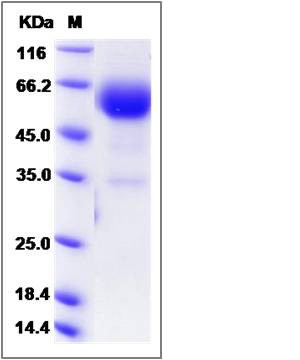Mouse BTLA Protein (Fc Tag)
A630002H24
- 100ug (NPP1090) Please inquiry
| Catalog Number | P51060-M02H |
|---|---|
| Organism Species | Mouse |
| Host | Human Cells |
| Synonyms | A630002H24 |
| Molecular Weight | The recombinant mouse BTLA /Fc is a disulfide-linked homodimer. The reduced monomer comprises 388 amino acids and has a predicted molecular mass of 437 kDa. The apparent molecular mass of the protein is approximately 57-62 kDa in SDS-PAGE under reducing conditions due to glycosylation. |
| predicted N | Glu 30 |
| SDS-PAGE |  |
| Purity | > 90 % as determined by SDS-PAGE |
| Protein Construction | A DNA sequence encoding the mouse BTLA (Met1-Gly176) was expressed, fused with the Fc region of human IgG1 at the C-terminus. |
| Bio-activity | Immobilized mouse BTLA-Fc at 10 μg/ml (100 μl/well) can bind biotinylated mouse HVEM-Fch (P10567-M03S), The EC50 of biotinylated mouse HVEM-Fch (P10567-M03S) is 15.7-36.7 ng/ml. |
| Research Area | Signaling |Signal Transduction |ITIM/ITAM Immunoreceptors and Related Molecules |
| Formulation | Lyophilized from sterile PBS, pH 7.4 1. Normally 5 % - 8 % trehalose, mannitol and 0.01% Tween80 are added as protectants before lyophilization. Specific concentrations are included in the hardcopy of COA. |
| Background | BTLA is a inhibitory molecule which belongs to the Ig superfamily. It down-modulates immune responses. As such, reagents that regulate the binding of BTLA to its ligand or alter BTLA signaling have significant therapeutic promise. BTLA is crucial to understand the mechanism(s) of action of these antibodies before attempting clinical applications. BTLA is not expressed by naive T cells, but it is induced during activation and remains expressed on T helper type 1 (T(H)1) but not T(H)2 cells. BTLA is a third inhibitory receptor on T lymphocytes with similarities to cytotoxic T lymphocyte-associated antigen 4 (CTLA-4) and programmed death 1 (PD-1). |
| Reference |
